i plan on using the Mianne benchwork for my new 9.5'x22' layout and topping it with ¾" plywood. I live in Plymouth, MA. I would like your opinion of the preferred type/brand to use and where I may purchase it locally. Looking for good to very good quality.
Replies sorted oldest to newest
3/4 inch is overkill...just get the best quality 1/2 inch plywood available at your local Lowe's, Home Depot, or Menards.
-Greg
Thanks. A question I have/will have when I start my layout later this year.
Just googled your area. Try Goodrich Lumber and check out the 3/4" floor underlayment square edge. It's designed to stay flat for a long time.
They have homosote too, if you are going that route.
The Depot may have some decent stuff. Try to find 7 plys .
I use 1/2" lauan plywood, a thicker version of the underlayment they use on floors. It was special order from a real lumber yard at $34 a sheet. I like it because the veneers are thin, almost like marine plywood, both sides are perfect and it is light and strong, flatter and more rigid than 1/2" construction plywood. I use quite a bit of the lauan for stuff like shelves, workbenches, etc. You wouldn't build furniture out of it but for utility stuff it the best material I have found.
I did note that for the same price I can buy 1/2" sanded poplar plywood at Home Depot. It looks nice, but don't know how strong it is; I suspect it is the usual softwood layers in the center with two hardwood skins for the faces. The lauan is the same material inside and out.
I use the Mianne benchwork too. You may need some more of the little brackets that hold the top on, they send only 1 for each leg on the order, which may or may not be enough. I would also suggest that you put felt pads on the bottom of the height adjusters before you assemble it. You will also find it much easier to level the benchwork, assuming it is of any size, after the plywood is on; the basic benchwork is so light that it is sometimes hard to get all the legs to touch the floor without some weight on it!
I use 1/2 thick Baltic Birch....and recommend it.
I agree with PLCPROF on the 1/2" luan plywood. He mentioned strength of the plywood we use for layout building. Pretty much any 1/2" plywood is more than sufficient for our needs. What you want to avoid are some of the "Sheathing" grade plywoods, as they have voids, which while not particularly a strength issue on full sheets, become a nuisance on smaller cut pieces.
Baltic birch is about the best for stability.
My whole layout is 1/2 mdf a few months ago i bought a 4x8 of 3/4 birch PLywood cabinet grade for another project (rear hatch on a boat to be fiberglassed in) anyways i only needed a 30x60 Piece for the boat so the rest became train layout property I'll be honest if i was redoing my layout i would do it in that. its teh area now where my transfer table is simple to work with and the screws grab hard in it. here is the area
agree that 3/4 is over kill, not to mention HEAVY. 1/2 is more than enough
I used 1/2" MDO, Medium Density Overlay. One, or both sides have a laminate that is designed to be painted. Does well with all the water and glue mixture. Most lumber yards, MDO would also, be a special order. I did use a piece of 1/2" A/C grade exterior plywood on the Coal tipple section. A grade, top surface side, C grade bottom. No voids. Exterior grades have glues that are somewhat water safe.


Coal tipple area.
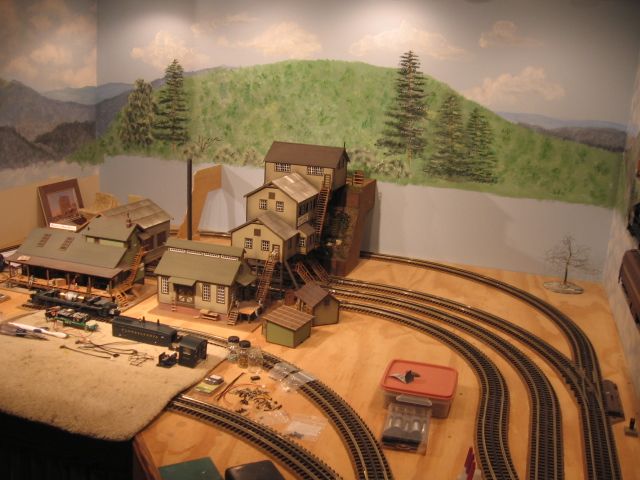
If I was just making a flat table top, a excellent grade of 1/2" will work. If doing the open grid where plywood is just under tracks an excellent grade of 3/4" would be better.
Clem
if you are planning on walking on the layout then 3/4 is the way to go. I have seen damage to track work and scenery etc. from the flex of standing on 1/2". the cost is only slightly more. if it is an around the room layout where climbing on the layout will not happen then 1/2 or even 3/8 is fine. better quality ply is more stable, but for O gauge it is not as important as in HO.
I make a frame of 1x4" #2 pine that I put underneath my 1/2" Baltic Birch....and can walk on it w/o any trouble. And I haven't been skinny in quite some time.
It can be a pain in the butt to find, depending on where you live, but it's hard to beet Baltic Birch for a table top surface, IMHO. There's a reason cabinet makers use it. ![]()
I used 3/4 plywood. $10.00 for a 4 X 8 sheet. It was cheaper then the cheapest OSB at the big box stores. I found it at a Builders Surplus Store.
Most of the plywood's mentioned here are fine but how much strength do you really need? A typical layout has less than .01 psi of weight on it. My layout uses 1/2" 5 ply plywood (actually 15/32") top side sanded. I have never experienced any problems in the entire 28' x 15' setup. The plywood is on a table frame made of 3/4" x 4" pine and everything is screwed and glued down. If your table work is in the basement or in a heavy humid environment, I would avoid Masonite or flakeboard in the construction. It holds up poorly in high humidity.
I use 1/2 inch, 4' by 8' sanded plywood sheets, mounted to L girder contructed tables, I have elevated double line track above this plywood deck, the L girder construction allows for localized stiffening of the plywood sheet if deflection(sagging) is an issue, as someone mentioned previously the plywood sheet weight becomes a issue especially when the layout is in the basement(attic) and stairs are an issue, the other consideration is the cost difference between 1/2 and 3/4 plywood sheet. Check the web for a rope sling for carrying plywood.
If you haven't yet purchased the Mianne material yet please compare the cost with using 1x4 pine lumber for the framing and legs. Pick up a copy of Linn Wescott's book on benchwork and learn about L Girder construction and open grid techniques. The book has been out for decades and is available new or used on Ebay, Amazon or from Kalmbach the publisher. Two pieces of 1x4 at 90 degrees make very strong legs. 1/2 inch quality A-C plywood is perfectly fine. 3/4 inch is too heavy to handle and has little ability to flex which you may want it to do for grades.
I concur - 3/4" plywood will not hurt, but is not necessary. I have used 1/2", 5/8" and in between - whichever was cheaper at Home Depot, Lowe's, or other places.
Also, just about any grade plywood will do - A/A, A/B, A/C, B/C - the only issue with the lesser grades is that they may have more splinters, which may be harmful to your hands, but the trains couldn't care less. After all, when done, the only plywood surface you will see will be under the layout.
My 2¢
Good Luck!
Alex
turbgine posted:Two pieces of 1x4 at 90 degrees make very strong legs. 1/2 inch quality A-C plywood is perfectly fine.
That's what I use...and they're very, very strong indeed. #2 or better 1X4 stains up very nicely, if you're so inclined.
I also use lag bolts instead of screws when securing my legs to my frame. It's much easier to take down/apart if necessary. Being able to separate your legs from your "table" makes it much easier to get through doorways should you have to move the layout.
Gentlemen,
Alex is absolutely correct, depending on your under pinning you can use different thicknesses, I use 3/4 finished right now, because my Christmas layout now sits on Saw Horses each year, I want the thicker stronger more rigid Ply. If I use conventional 2x4 or 2x6 attached to the wall, along with fold up legs, I would use the 1/2 as I did in the past. You can use different thickness depending on the engineering you choose to build with.
PCRR/Dave
Just my opinion but, I would use the 3/4" plywood. Why? On our layout, there were/are places that more than one adult needs to be on top of the layout doing track laying, scenery, electrical repairs to the Atlas turnouts, etc. Thus, we went with all 1"X4" lumber for legs, glued together in a "L" shape. The top cross structure is all 1"X4" lumber with 1"X2" glued on top for an "L girder". The 3/4" roofing plywood was then laid on top and screwed down.
We have had as many as 5 adults working on top of the layout, during various stages of vinyl road bed laying, track laying, ballasting, and scenery/building installations. The layout is NOT anchored to anything, but is EXTREMELY strong/sturdy, and if you bump into it, you will hurt your side, yet the layout does not budge.
Avoid Chinese plywood. It warps very easily.
I had seen some Indonesia luan board that delaminated quite easily, IMO, poor quality adhesive. There should be markings on each board, as to origin.
I also vote for 3/4" if you need to walk on the layout. I have been spending time up on mine these days and I can tell you it's a whole lot stiffer than the 1/2" I had on the last layout.
Anyone see an issue using 1/2 inch sheathing with 1/2 inch homosote on top?
I think that will work fine, as long as you don't want to carve cuts for streams, roads, etc. 1/2 inch ply will support a lot if properly girdered underneath.
Homosote is expensive and dusty if you cut it with a saw.
OaklandOGauge posted:Anyone see an issue using 1/2 inch sheathing with 1/2 inch homosote on top?
That's what I used and never had an issue.
The Fort Pitt Highrailer modules are done with 3/4" sheet board (Framing) 16" to 24" on center and 1/4 (7/64)" luan board for decking. The face boards double the side rails to 1 1/2" Standard modules are about 37 1/2" X 6 ft. (4) legs per module. (2) leg assemblies that fit between the clamp boards pictured.
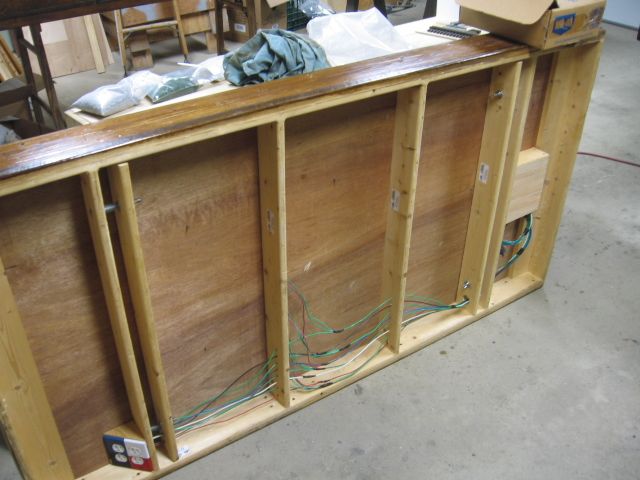
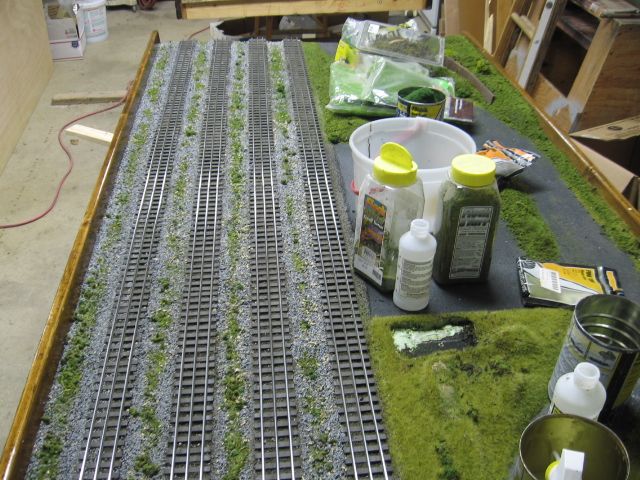
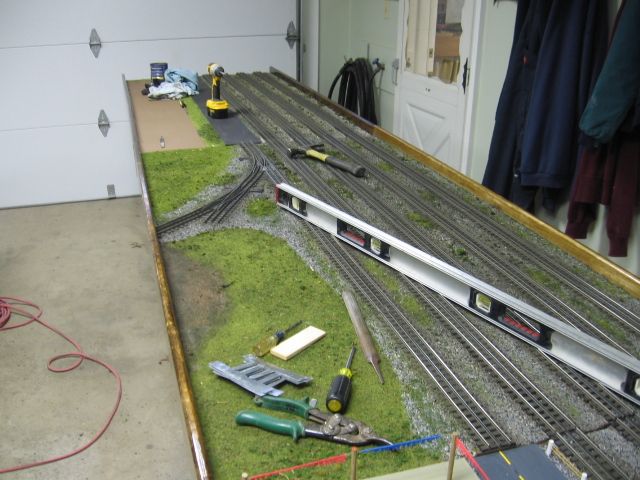
Leg assemblies. They are universal. Most of the assemblies will fit every module.
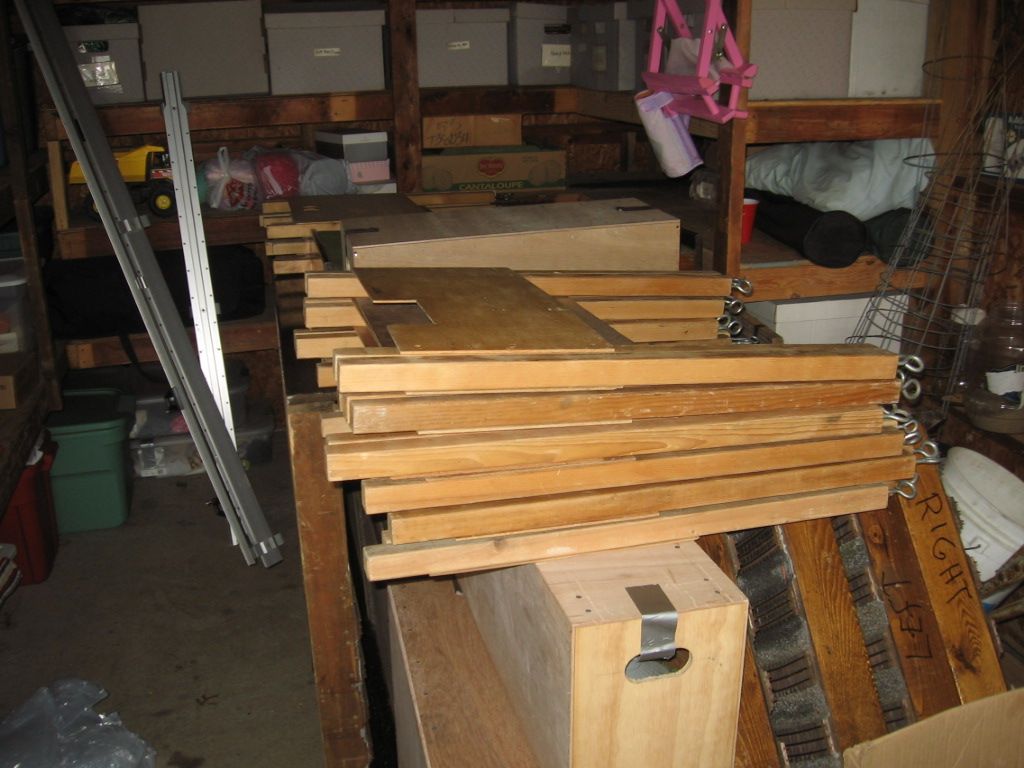
Thanks for the replies. This is helpful.
Mianne recommended 1/2" Sandply from Home Depot. I was going to use Birch, but after looking at them both the Sandply was 5 ply and the Birch was only 3 ply. More plies is better, I agree with Mianne and used the Sandply. Home Depot cut it for me so I could handle it as I can't handle 4'x8' sheets anymore. There was no additional charge for cutting.
After getting my benchwork up and going I ordered a transformer cart from Mianne. It came with Sandply for the top and lower shelf. The Sandply was about $34-$35 for a 4'x8' sheet (same as the Birch was) about a year and a half ago here in the Midwest.
I started building my first layout last August, and I chose to use Mianne benchwork. I could not be more pleased with the product. I am not a great carpenter, and the pre-made benchwork was a perfect solution. I knew I would be assembling everything myself, so ease of assembly was paramount to me, and following the included instructions made the project move along smoothly. Each step in the assembly resulted in a rather lightweight assembly that was easy to move. My layout is a 16'x14' round the room setup with a 48" island running down the middle. I spent three or four hours a day over about a week assembling everything - being retired, I tend to take things rather slower than I used to. I also used 1/2" Sande Plywood from Home Depot (app. $32/ 4'x8' sheet), and has been noted, HD cut the sheets to size for me at no charge. I also used 1/2" homasote over the plywood (app. $29/ 4'x8' sheet) and HD was kind enough to cut them at the same time as the plywood so the sizes matched. I've knelt on the layout, but not stood on it, with no problems. As JMILLER pointed out, homasote is dusty when cut, so you REALLY don't want to cut it in the house - whatever HD didn't cut, I made sure to cut outside.
Best of luck with your build.
rtr12 posted:
sand ply was 5 ply and the Birch was only 3 ply. More plies is better
more plys is NOT better, the quality of the plys is what counts.
look at these pictures, 5 ply 3/4 walnut $135, all solid poplar plys with walnut veneers.
then look at 12 ply 3/4 Chineese ply from HD $35, many plys, but all are scrap. because these plys overlap, they are under stress and will move in unexpected ways. baltic birch is very expensive and overkill for a layout top.
when looking for good plywood pay attention to the quality of the plys, not the amount of them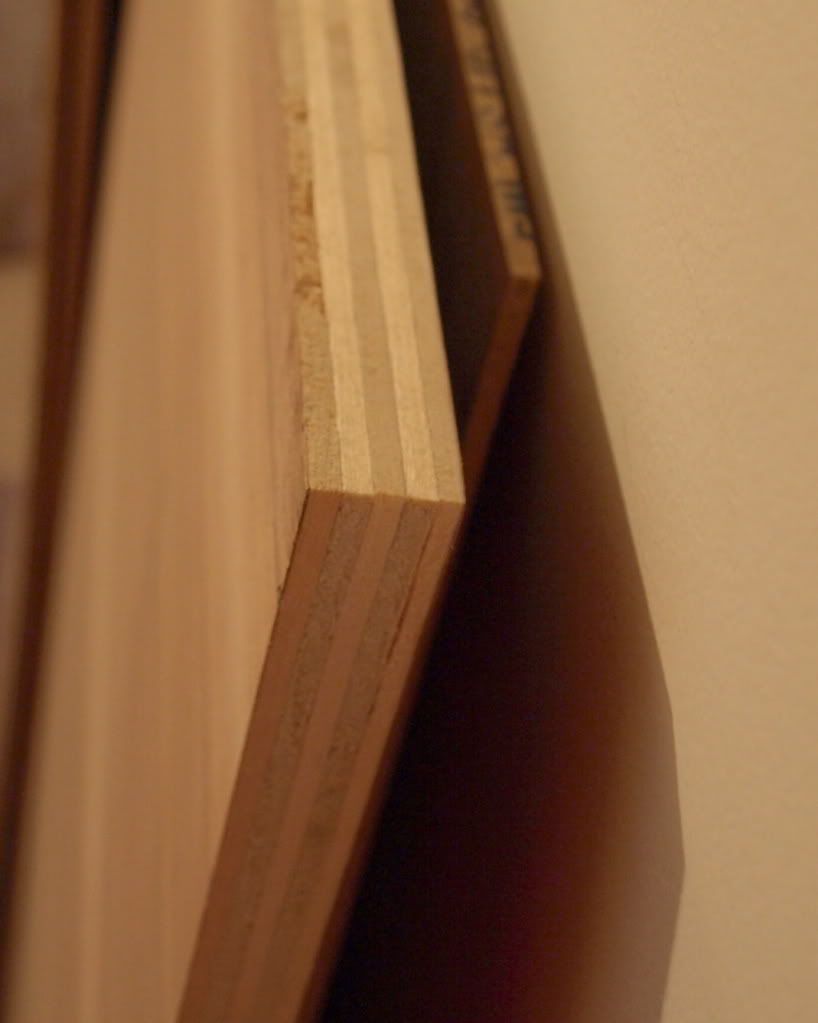
What's wrong with using osb, 7/16 thick? That's what i plan using.
I cut Homasote with an Airway #6 knife. Sold in floor covering supply houses. Multiple passes. Totally dust free. The blade is twice as sharp as a box cutter and half the thickness.
Yes, The OSB can be used successfully depending on a dry environment and sealed edges. I have one job 23 years old in perfect shape.
On my present RR I am using a wide assortment of panels and a variety of thicknesses purposefully to document performance. Including OSB under one of my yards.
mytrains posted:rtr12 posted:sand ply was 5 ply and the Birch was only 3 ply. More plies is better
more plys is NOT better, the quality of the plys is what counts.
look at these pictures, 5 ply 3/4 walnut $135, all solid poplar plys with walnut veneers.
then look at 12 ply 3/4 Chineese ply from HD $35, many plys, but all are scrap. because these plys overlap, they are under stress and will move in unexpected ways. baltic birch is very expensive and overkill for a layout top.
when looking for good plywood pay attention to the quality of the plys, not the amount of them
Well I can't argue with that piece of scrap you posted above, maybe I should have been more clear. I was referring to plywood like your walnut example for the comparison of number of plys. The Sandply is a furniture/cabinet grade plywood like their birch, maple and oak. In comparison of this examples, more plys is better. Also, I have never seen anything as bad as that Chinese plywood at my local Home Depot here, but I will scour the racks next time I visit to see if it does exist in the store. I will also check online. Their yellow pine sheathing is better than that, although that would still be a very poor choice for a layout top, as that also warps easily.
Hopefully, no one considers the above scrap as a quality grade of plywood, but I do realize a lot of folks go for price alone when purchasing something like this. Suppose I should have, but I had not considered the 'price alone factor' as what I would be thinking about when looking for plywood for my layout top.
I usually buy MDF 1/2 but like I said earlier I bought some 3/4 birch and what a difference well worth the extra $$ I bought it to replace the light Balsa sandwiched in between fiberglass on a rear hatch of a boat but the extra became layout wood Glad it did MY elevated track will ride on it with tw train worx supports. should make for a sturdy elevated section.
feet posted:What's wrong with using osb, 7/16 thick? That's what i plan using.
Personally, I would not use it, but I think some folks have used OSB for their layouts with some success. I really don't know a lot about it and have never used it for anything, but I believe it would be less subject to warping than the sheathing grade of plywood at Home Depot. I have always tried to use a good grade of plywood for everything I have built.
When I got my layout top, I thought the Home Depot Sandply was a good quality at a fair price, which was around $34-$35 for a 4'x8' sheet of 1/2" when I got mine, but I only needed 3 sheets. Had I needed 30 sheets, I may have looked into something else? Although in many (maybe most) cases, 30 sheets would still be less than just one new scale sized steam engine.
Gonna have to agree with the drive by Home Depot or Lowes comments. Some of the worst wood and boards I've ever seen was on sale at those stores.
Next time you're in one, walk by the bundles of plywood and pay attention to how warped or bent some of the boards are.
It takes me FOREVER to find usable 2x4s sometimes.
They're open late, seven days a week and are usually easy to find across the country. But the quality....and service....are lacking.
Ultimately, you get what you pay for.




